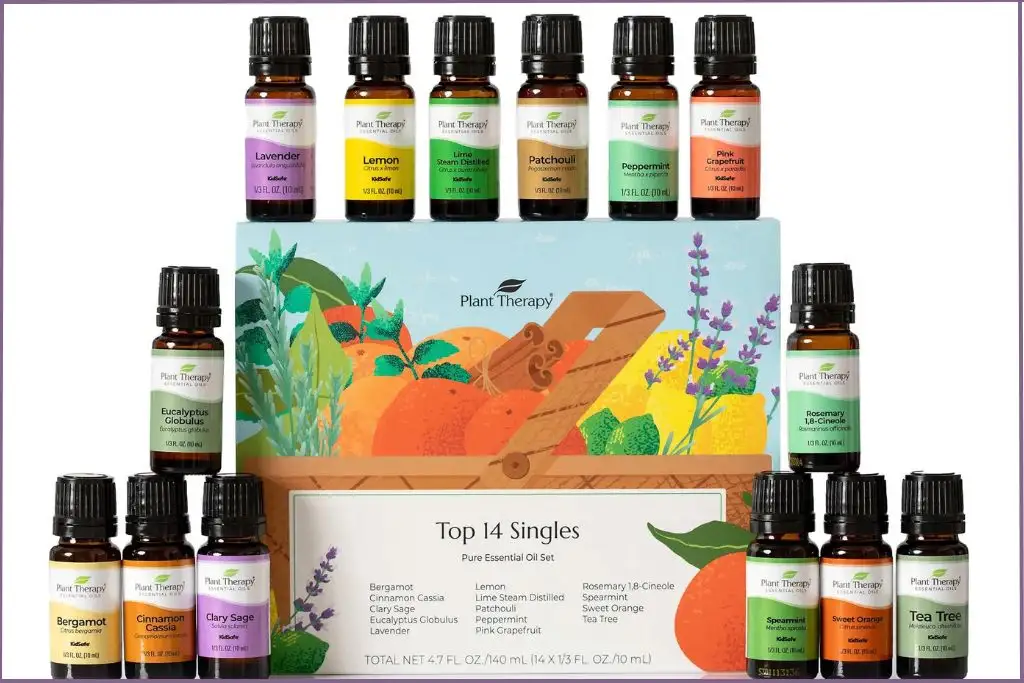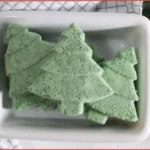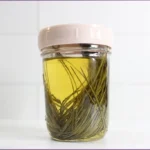Aromatherapy bath safety is key to a relaxing and rejuvenating experience.
Using essential oils in the bath can transform an ordinary bath into the ultimate relaxing spa session – but only if you do it right.

✨ Get 12 Free Holiday Diffuser Blends — Printable PDF
Instantly make your home smell like Christmas with these festive, ready-to-use recipes.
While the allure of an aromatic soak is strong, understanding the potential risks is crucial to ensuring a safe and enjoyable experience. Essential oils are highly concentrated extracts and using them correctly is crucial.
These aromatherapy bath safety tips will help you get the most of your bath time without the potential risks.
Table of Contents
Affiliate Disclosure: Some links on this site are affiliate links. I may earn a small commission if you purchase through them, at no extra cost to you. See the full affiliate disclosure.
1. Never Add Essential Oils Directly Into The Bath

It may seem straightforward – you run a bath, put a few drops of your favorite essential oil and get in, right? Wrong.
When using essential oils in the bath, the first and most important rule to remember is that you never add essential oils directly into the water.
Oil and water don’t mix. When you add essential oils directly into the water the oil drops will just float to the top. Even if you stir it in, it won’t blend with the water. Instead, the oil will simply form smaller droplets that still float around in the water.
When you get into the tub, the oil droplets will come in direct contact with your skin. This acts the same way as if you’ve applied the undiluted oil directly to your skin. This direct contact with the concentrated oil can irritate or even burn sensitive skin.
Read any article on using essential oils topically and they all always emphasize that these oils should never be used on the skin directly in their concentrated form.
2. Always Dilute Essential Oils With Carrier Oil First Before Adding To The Water

Essential oils must be diluted for all topical applications, this includes using them in the bath.
When you mix essential oils with a carrier oil, the two oils blend. When the blend of oils is added to the water, the carrier oil will float on top of the water with the essential oil safely diluted in it. Your skin comes in contact with the diluted blend, which will not cause any irritation.
Carrier oils also help to moisturize the skin, which is an added benefit. I would always advice using the best quality carrier oil you can afford just as you would when buying a body lotion.
Tip 3: Less Is More When Using Essential Oils In The Bath
A few drops (6-8) are all you need to get the benefits of adding essential oils in your bath. Don’t be tempted to add more before you like the aroma of the oil. With essential oils, more is not always better.
These concentrated extracts are powerful, and a little goes a long way.
Mix your chosen essential oil with 1–2 tablespoons of carrier oil first and then add the mix of oils into the water to create an aromatic, therapeutic spa session.
The best carrier oils to use in a bath are coconut, jojoba, olive and avocado oil.
Children require even less – usually just 1-3 drops, and only under professional guidance.
Add the essential oil + carrier oil mix into the water and stir the water around to disperse the oils. After doing this, it’s time to step in.
Start with the lowest recommended amount and pay close attention to how your body responds. If you experience any discomfort, reduce the quantity or discontinue use.
4. Add The Oils To The Bath AFTER Filling The Tub And Closing The Tap

Most people get this wrong when using essential oils in the bath. We are accustomed to putting in the bubble bath before opening the tap so that it works up a nice lather and assume that it’s the same with essential oils. It isn’t.
Essential oils are highly volatile. If you add the essential oil in the tub first and then open the faucet, the hot running water will cause the essential oils to evaporate into the air with the steam. That’s a waste of the essential oil and reduce its benefits.
To get the maximum benefits of your aromatherapy bath, you must add the essential oil + carrier oil mix into the water AFTER you’ve filled the tub and closed the faucet.
Add the oil mix into the water and agitate the water gently so the oils disperse evenly in the water. Your essential oil bath is now ready for you to get in and relax.
5. Don’t Run A Very Hot Bath

This ties in with tip #4. Very hot water will cause the essential oils to evaporate along with the steam so you won’t get the full benefits.
Also, high heat compromises the delicate therapeutic compounds in essential oils, reducing their effects, which defeats the purpose of an aromatherapy bath.
Lastly, very hot water is dehydrating and will leave your skin looking dry and flaky.
6: Know Your Skin Sensitivity
Your skin is a unique ecosystem that responds differently to various substances. What works wonderfully for one person might trigger a significant reaction in another.
Before fully embracing an aromatherapy bath with a new essential oil, it’s critical to perform a patch test. This simple process involves applying a small, diluted amount of the essential oil to a discreet area of skin, such as the inside of your wrist, and waiting 24 hours to observe any adverse reactions.
Look for signs of irritation like redness, itching, burning, or swelling. These symptoms indicate that the particular essential oil may not be suitable for your skin type. By taking this precautionary step, you can prevent potentially uncomfortable or dangerous full-body reactions.
7. Use Only The Highest Quality Essential Oils
Investing in high quality essential oils is so very important for several different reasons.
High quality essential oils are extracted using advanced techniques that produce a 100% pure oil. This ensures that you get the most from the oil’s therapeutic properties.
Also, your skin will be coming in contact with the oil when you soak in the bath, even if indirectly. Using 100% pure essential oils minimizes the risks of skin irritation.
When buying essential oils look for bottles that clearly display botanical names, provide transparent sourcing information, and be certified organic when possible. Beware of oils with suspiciously low prices or vague labeling.
I highly recommend using Plant Therapy’s organic essential oils to use in the bath. The brand invests in rigorous testing and ethical sourcing to ensure the purest end product.

While buying their individual oils is great value by itself, you’ll save even more when you buy one of Plant Therapy’s essential oil sets. This Top 14 Singles Set by Plant Therapy is the best value you can get with 14 commonly used essential oils at one low price.
8. Always Read The Instructions On The Label
Every essential oil has its own distinctive features and precautions.
If you are new to aromatherapy or this is the first time you are using essential oils in the bath, take time to read the instructions on the label.
Make note of any precautions or special instructions mentioned on the label.
9. Avoid Using These Essential Oils in Your Aromatherapy Bath
Some essential oils are too strong or irritating for use in bathwater, even when diluted. Avoid these oils:
Cinnamon & Clove: Cinnamon and clove essential oils have strong warming properties. Soaking in a bath with these oils can cause skin irritation or burning, especially if you have sensitive skin.
Oregano & Thyme: Known for their intense properties, oregano and thyme can be too harsh for direct skin contact.
Citrus essential oils: While citrus essential oils are energizing and smell delightful, these oils can cause photosensitivity, meaning your skin becomes extremely vulnerable to sun damage. If you do add a citrus oil in your bath, avoid exposure to the sun for at least the next couple of hours..
Wintergreen: Wintergreen methyl salicylate, which may be toxic in large amounts and is unsafe for children.
Always research an essential oil’s properties and safety guidelines before using it in your bath.
10. Recognize & Respond to Adverse Reactions
Knowledge is your first line of defense. Be aware of potential warning signs of an adverse reaction, which might include intense skin burning, the development of a rash or hives, difficulty breathing, dizziness, or nausea.
If you experience any of these symptoms during or after an aromatherapy bath, exit the tub immediately, rinse your body thoroughly, and pat dry.
Applying a bland carrier oil like coconut oil can help soothe irritated skin.
In cases of severe reactions, don’t hesitate to seek medical attention. Keep a record of which oils you used and your symptoms to help healthcare professionals provide appropriate treatment.
11. Keep Medical Considerations & Contraindications In Mind
Aromatherapy is not a one-size-fits-all solution. Certain individuals need to exercise extreme caution or avoid essential oils altogether.
Children and elderly individuals have more sensitive skin, making them particularly vulnerable to the concentrated nature of essential oils.
If you’re pregnant or breastfeeding, you must consult with your doctor before using any essential oils in the bath or even in the diffuser, as some may cause complications.
You must be particularly cautious if you are on medication, dealing with chronic conditions or have with compromised immune systems. What might be a gentle, healing experience for one person could be overwhelming or harmful for another.
If you’ve never used essential oils before, you must consult your healthcare provider to understand how aromatherapy might interact with your specific health profile.
12. Clean The Tub Thoroughly After Your Aromatherapy Bath
While the amount of essential oil you use in a full tub may not make it noticeably slippery during your bath, residual oils can cling to the sides and bottom of the tub after the water has drained.
This buildup creates a slippery surface, which could be hazardous the next time you step into the tub.
To prevent accidents and maintain a clean bathing environment, make it a habit to clean your tub after each aromatherapy bath. A quick wash using baking soda and castile soap is effective and eco-friendly.
Baking soda acts as a natural abrasive, cutting through oil residues, while castile soap’s de-greasing properties help lift and remove any lingering oils.
For a more thorough clean:
- Sprinkle baking soda generously over the tub’s surface.
- Use a sponge or cloth with a small amount of castile soap to scrub the area, focusing on spots where oils tend to collect.
- Rinse thoroughly with warm water to ensure no residues are left behind.
Aromatherapy baths offer a wonderful opportunity for relaxation, healing, and self-care. The key is to understand how to use essential oils in the bath safely.
Remember, the goal is not to restrict your enjoyment but to empower you to use aromatherapy wisely. Listen to your body, start slow, and always prioritize your well-being.




